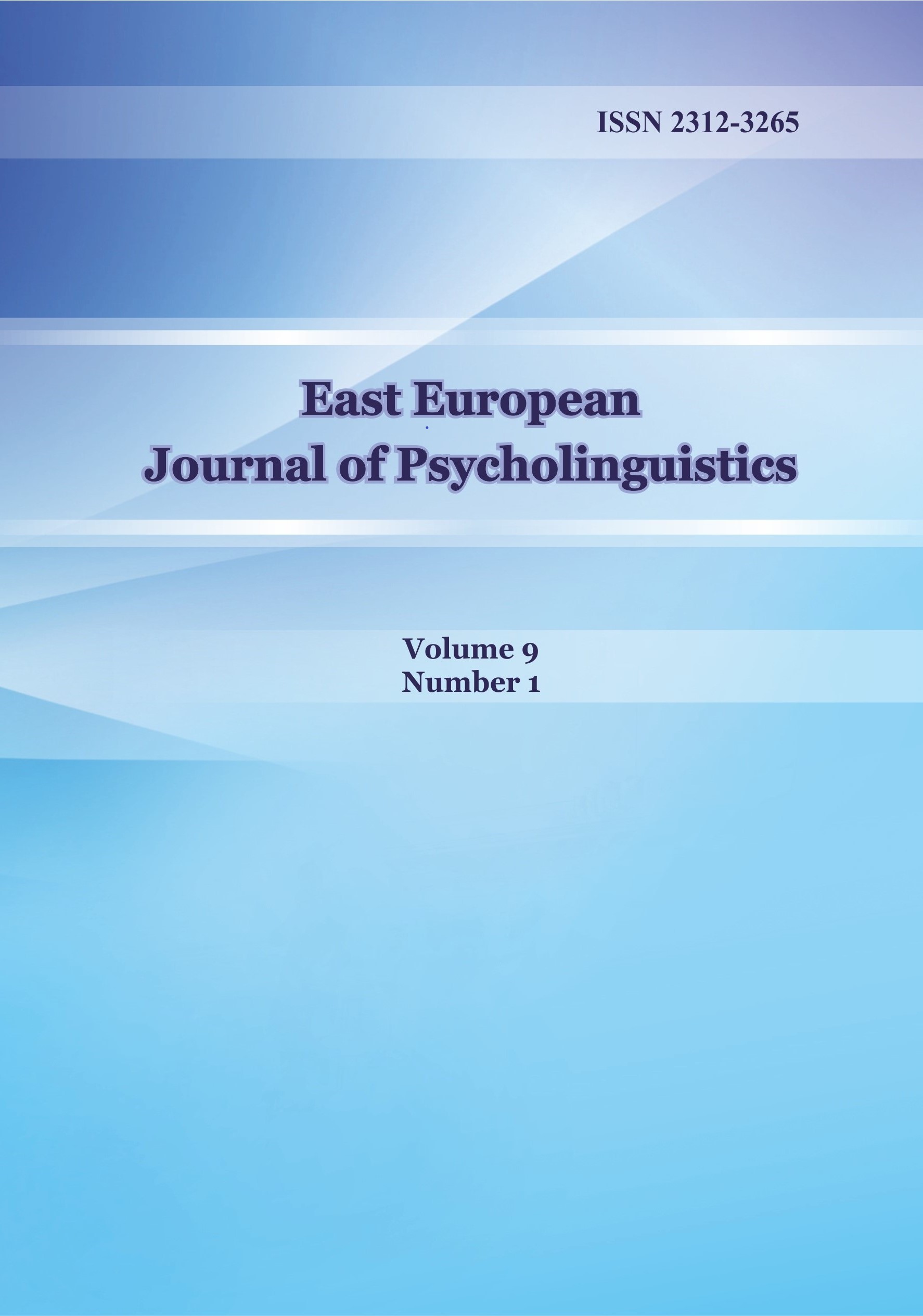A Category With Multiple Centers: The Case of the Ukrainian Verbal Prefix Za-
DOI:
https://doi.org/10.29038/eejpl.2022.9.1.staKeywords:
categorization, category structure, radial category, prototype, verbal prefix, Ukrainian, cognitive semanticsAbstract
The present study aims to reconstruct the structure of the Ukrainian verbal prefix za- as a category. Cognitive modeling and the network approach are used to this end, similarly to other works within the Cognitive Linguistics paradigm (Janda 1985, 1986), (Sokolova & Endresen, 2017), (Tabakowska, 2003). The modeling phase is preceded by an analysis of a large sample of Ukrainian za- verbs, which are grouped into semantic blocks based on shared semantic content. These blocks are then mapped onto a network of conceptual schemas, which includes such prominent centers as CURVE and APPEAR. The latter and several other nodes are shown to be modifications of CURVE with the links between them constituting family resemblances (Wittgenstein, 2009). The conceptual schema APPEAR is actively used by native speakers to coin new inchoative za- verbs in Ukrainian and several Slavic languages, which means that conscious (Type 2) categorization (Starko, 2014) is employed. This and other considerations suggest that APPEAR is a psychologically real conceptual entity in its own right. Thus, an argument is made in favor of a bifocal, rather than unicentric, topology of the za- network, which is contrary to the popular assumption about the existence of a single central element (prototype) from which all other network nodes are derived in what is called “radial structure” or “radical category” (Lakoff, 1987). The a priori assumption in the study of categories should be that they may be unicentric or pluricentric.
Acknowledgements
This research was supported by a grant from the Humanities Faculty of the Ukrainian Catholic University (Lviv, Ukraine).
Downloads
References
Haspelmath, M. (1997). From Space to Time: Temporal Adverbials in the World’s Languages. München — Newcastle: Lincom Europa.
Ilyin, V. (1953). Prefiksy v suchasnii ukrainskii movi [Prefixes in Modern Ukrainian]. Kyiv: Vydavnytstvo AN URSR.
Janda, L. A. (1985). The meaning of Russian verbal prefixes: Semantics and grammar. In M. S. Flier & A. Timberlake (eds.) The Scope of Slavic Aspect. (pp. 26–40). Columbus, OH: Slavica.
Janda, L. A. (1986). Semantic Analysis of the Russian Verbal Prefixes za-, pere-, do-, and ot-. Munich: Otto Sagner. [Slavistische Beiträge, 192].
Karpilovska, Ie. (1990). Konstruiuvannia skladnykh slovotvorchykh odynyts [Constructing Complex Word-Formative Units]. Kyiv: Naukova dumka.
Lakoff, G. (1987). Women, Fire, and Dangerous Things: What Categories Reveal About the Mind. Chicago & London: University of Chicago Press.
Mazurkiewicz-Sułkowska, J. (2005). Czasowniki inchoatywne z prefiksem za- w języku bułgarskim i ich odpowiedniki w polskim i białoruskim. Acta Universitatis Lodziensis. Folia Linguistica, 43, 59–69. Retrieved from http://hdl.handle.net/11089/16564
Nedelcheva, S. (2016). Chislata v kognitivnata lingvistika. Opredeliane prototipa na prefiksa ZA-: chestotnost ili yarkost [Numbers in Cognitive Linguistics. Defining the prototype of the prefix ZA-: frequency vs. salience]. Lyubosloviye, 16, 88–104.
Rakhilina Ye. & Plungyan, V. (2014). Semantiko-sintaksicheskiye svoystva russkikh konstruktsiy s predlogom pod: primyie (prostranstvenniye) i perenosnyie (vremennýie) upotrebleniya [Semantic and Syntactic Features of Russian Constructions with the Prefix pod: direct (spatial) and figurative (temporal) uses]. Die Welt der Slaven, LIX, 22–56.
Rosch E. & Mervis, C. (1975). Family resemblances: studies in the internal structure of categories. Cognitive Psychology, 7, 573–605. https://doi.org/10.1016/0010-0285(75)90024-9
Sokolova, S. (2003). Prefiksalnyi slovotvir diiesliv u suchasnii ukrainskii movi [Prefixal Derivation in Modern Ukrainian]. Kyiv: Naukova Dumka.
Sokolova, S. & Endresen, A. (2017). The Return of the Prefix za-, or What Determines the Prototype. In A. Makarova, S. M. Dickey, & D. Divjak (eds). Each Venture a New Beginning: Studies in Honor of Laura A. Janda. (pp. 239–256). Bloomington, IN: Slavica Publishers.
Starko, V. (2014). Categorization, Fast and Slow. East European Journal of Psycholinguistics, 4(1), 205–212. Retrieved from https://eejpl.vnu.edu.ua/index.php/eejpl/article/view/88/71
Tabakowska, E. (2003). Space and time in Polish: The preposition ZA and the verbal prefix za-. In: H. Cuyckens, Th. Berg, R. Dirven, & K.-U. Panther (eds). Motivation in language: Studies in honor of Günter Radden. (pp. 153–177). Amsterdam: John Benjamins.
Wittgenstein, L. (2009). Philosophical Investigations. Rev. 4th ed. Oxford: Wiley-Blackwell.
Zaliznyak, A. (2006). Mnogoznachnost v yazyke i sposoby yeye predstavleniya [Polysemy in Language and Ways of Its Representation]. Moscow, Yazyki slavianskikh kultur.
Zhuykova, M., Lavrynovych, L., & Svidzynska, O. (2020). The Structure of Basic Level Categories in the Ukrainians’ Consciousness According to the Results of Psycholinguistic Experiments: PARKAN and MUR. East European Journal of Psycholinguistics, 7(2), 243–256. https://doi.org/10.29038/eejpl.2020.7.2.zhu
Sources
Rysin A. & Starko, V. Large Electronic Dictionary of Ukrainian (VESUM). Version 5.8.0. 2005–2022. Retrieved from https://github.com/brown-uk/dict_uk
Downloads
Published
Issue
Section
License
Copyright (c) 2022 Vasyl Starko

This work is licensed under a Creative Commons Attribution 4.0 International License.










 Creative Commons «Attribution» 4.0
Creative Commons «Attribution» 4.0